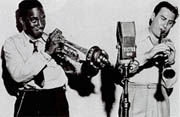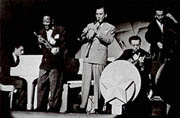Artie Shaw
 Arthur Jacob Arshawsky was born in 1910 to Jewish-immigrant parents in New York. His family moved to New Haven, Connecticut during his developmental years, where at fourteen he began to play the saxophone and a few months later the clarinet. By the time he was fifteen he had left home and changed his name to Artie Shaw and was playing all over the country.
Arthur Jacob Arshawsky was born in 1910 to Jewish-immigrant parents in New York. His family moved to New Haven, Connecticut during his developmental years, where at fourteen he began to play the saxophone and a few months later the clarinet. By the time he was fifteen he had left home and changed his name to Artie Shaw and was playing all over the country.
When he was sixteen he went to Cleveland, where he stayed for three years, spending two of those three with Austin Wylie, Cleveland’s top bandleader. Artie heard his first “race” records in 1927, including Louis Armstrong’s recordings of Savoy Blues and West End Blues with his Hot Five. Shaw then took a trip up to Chicago’s Savoy Ballroom to hear the genius trumpeter in person.
At seventeen in 1928, Shaw won an essay-writing contest that brought him to Hollywood. There he met a few of the musicians he had known in New Haven who were now playing in Irving Aaronson’s band. Shaw would soon join them at the age of nineteen, and in 1930 the band spent the summer in Chicago. Here Shaw “discovered a whole new world,” as he put it when he heard recordings of some of the great classical composers of his era – Stravinsky, Debussy, Bartok, Ravel, etc.
In 1930 the band went to New York, and Shaw, age 21 made the decision to stay there. In less than a year, he had established himself as the top lead alto-sax and clarinet player in the system of New York radio and recording studios.
 Unlike most of his competitors and fellow bandleaders, being a bandleader was not at the top of Shaw’s occupation list. Early in his career, he retreated to the Pennsylvania woods for a year to refine his technical abilities on the alto saxophone and the clarinet. He made a living chopping wood and tried to train himself as a writer of books. Here he also made a deal with himself – he would do whatever it took in the music business to make $25,000 (then quite a lot of money), enough to back a literary career, and then retire to find out exactly what he wanted to do with the rest of his life. He also decided to pick up where he had left off in his formal education at the age of fifteen.
Unlike most of his competitors and fellow bandleaders, being a bandleader was not at the top of Shaw’s occupation list. Early in his career, he retreated to the Pennsylvania woods for a year to refine his technical abilities on the alto saxophone and the clarinet. He made a living chopping wood and tried to train himself as a writer of books. Here he also made a deal with himself – he would do whatever it took in the music business to make $25,000 (then quite a lot of money), enough to back a literary career, and then retire to find out exactly what he wanted to do with the rest of his life. He also decided to pick up where he had left off in his formal education at the age of fifteen.
Shaw returned to New York in 1934 and put his plan of continuing his education into action, taking up studio work again to support himself. In 1936, he made his first public appearance as a leader in history’s first swing concert at Broadway’s Imperial Theater. This was a huge point in Shaw’s career, as well as a major impact on American Big Band Jazz of the future. Shaw, absolutely unknown by the public, did something very peculiar with his three minute interlude time slot; he composed a piece for a strange jazz octet: his clarinet, a rhythm section without piano, and a string quartet. The piece was called Interlude in B-flat, and when the audience cheered for a curtain call, Shaw, having only that one piece prepared, had to play his Interlude again for the hugely delighted crowd.
At this time, Artie could not have predicted that in a few years he would be leading the country’s number one band with a smash hit, Begin the Beguine. Within a year of the release of Begin the Beguine, the Artie Shaw Band was making more than $60,000 a week – now more than $600,000 a week!! Soon before the release of this breakthrough hit he had hired Billie Holiday, whom he had previously dated.
Shaw had a sense of originality and taste in his music that would distinguish him from the other famous bandleaders of the day. His hiring of Holiday was groundbreaking in that this was the first white bandleader to hire a black female singer as a permanent member of his band and that he had pushed back the color barrier even more.
 His band was characterized by many unique features, including a string section in his first band, which helped established the terms “chamber jazz” and “Third Stream Music. He was also, along with Benny Goodman, a groundbreaking artist in that he could see no problem with having an integrated group. He and Goodman had broken the color barrier long before Jackie Robinson. Another thing about Artie Shaw that made him different from other bandleaders was the fact that he had enough confidence in himself and in his playing to let his sidemen – including pianist Dodo Marmarosa, sensational trumpeter Roy Eldridge (left), and others – have the spotlight more than once in a while.
His band was characterized by many unique features, including a string section in his first band, which helped established the terms “chamber jazz” and “Third Stream Music. He was also, along with Benny Goodman, a groundbreaking artist in that he could see no problem with having an integrated group. He and Goodman had broken the color barrier long before Jackie Robinson. Another thing about Artie Shaw that made him different from other bandleaders was the fact that he had enough confidence in himself and in his playing to let his sidemen – including pianist Dodo Marmarosa, sensational trumpeter Roy Eldridge (left), and others – have the spotlight more than once in a while.
 At the height of his popularity, Shaw’s recognition challenged even that of the aforementioned Benny Goodman, the King of Swing. The press then dubbed Shaw the “King of the Clarinet,” a title that further still challenged Goodman’s reign. The rivalry that followed this and other series of events lead faithful fans of one or the other to debate the accomplishments of each much in the fashion of die-hard sports fans. Indeed, as Artie Shaw’s name became more well known and his music even more so, Benny Goodman responded by removing the “rough New Orleans edges” in his playing to match Shaw’s smoother, cooler tone that was gaining him much publicity, as well as what he mockingly calls “$ucce$$.” (this artificial “rivalry” the media created between Artie Shaw and Benny Goodman was another factor that caused Shaw to quit show-business. They were simply two great musicians, friends, leading two different, fabulous bands.)
At the height of his popularity, Shaw’s recognition challenged even that of the aforementioned Benny Goodman, the King of Swing. The press then dubbed Shaw the “King of the Clarinet,” a title that further still challenged Goodman’s reign. The rivalry that followed this and other series of events lead faithful fans of one or the other to debate the accomplishments of each much in the fashion of die-hard sports fans. Indeed, as Artie Shaw’s name became more well known and his music even more so, Benny Goodman responded by removing the “rough New Orleans edges” in his playing to match Shaw’s smoother, cooler tone that was gaining him much publicity, as well as what he mockingly calls “$ucce$$.” (this artificial “rivalry” the media created between Artie Shaw and Benny Goodman was another factor that caused Shaw to quit show-business. They were simply two great musicians, friends, leading two different, fabulous bands.)
 For a musician in the music business for not much other than purely financial reasons, it is amazing how much Artie Shaw achieved in his relatively short career, one that went on and off from 1936 to 1955. He did, however, lead more bands than any other bandleader of his era, a total of five. Along with the unusually large number of bands that he would lead during his career, Shaw also put up an astonishing number of marriages; eight in total.
For a musician in the music business for not much other than purely financial reasons, it is amazing how much Artie Shaw achieved in his relatively short career, one that went on and off from 1936 to 1955. He did, however, lead more bands than any other bandleader of his era, a total of five. Along with the unusually large number of bands that he would lead during his career, Shaw also put up an astonishing number of marriages; eight in total.
It is also amazing how the music industry could transfigure this shy Jewish boy who had an obsession for music into a world-wide superstar. Shaw often could not deal with all of the fame and “success” that his music brought him; he retired on several occasions only to come back on almost all of these incidents. Although he loved the music he was playing, he did not have any good feelings for the music industry or his jitterbugging fans, dismissing them as “morons.”
 After retiring to Mexico, Shaw came back in March of 1940 and made another big hit, Frenesi. Shortly after the Japanese bombed Pearl Harbor, Shaw again quit music to enlist in the Navy (left). He was soon asked to form a service band which would spend the next year and a half bringing music to the troops in Pacific war zones, sometimes playing as many as four concerts a day! Upon coming back to the U.S. Shaw was given a medical dismissal from the Navy.
After retiring to Mexico, Shaw came back in March of 1940 and made another big hit, Frenesi. Shortly after the Japanese bombed Pearl Harbor, Shaw again quit music to enlist in the Navy (left). He was soon asked to form a service band which would spend the next year and a half bringing music to the troops in Pacific war zones, sometimes playing as many as four concerts a day! Upon coming back to the U.S. Shaw was given a medical dismissal from the Navy.
Shaw later studied the relation of the clarinet to non-jazz music in 1947 in New York, ending up in a tour of some of the best musical associations in the country. After the tour he recorded Modern Music for Clarinet, containing pieces by many famous composers of the time, including Cole Porter and George Gershwin. At about that time he appeared in Carnegie Hall, performed Mozart’s Clarinet Concerto with the New York Philharmonic, and played many chamber music recitals around the country.
1951 saw Artie Shaw quit the music business again, this time to write. Here he wrote a partially autobiographical book entitled The Trouble With Cinderella: An outline of Identity.
Because of his earlier actions in racial integration, The House Un-American Activities Committee called Shaw before them in 1953. He later remembered that the HUAC was “looking for prominent people.”
During the early fifties, Shaw had several big and small bands, along with his own symphony orchestra. One of these groups was what came to be known as the Gramercy 5. Shaw got the idea for the name of this group from the telephone exchange of New York. 1954 was Artie’s last public appearance as a musician, an appearance he made with a newly formed Gramercy 5. His clarinet was put away for the last time in 1954, and in 1955 he left the United States to live in Spain for a few years. Ten Years later, he had finished his second book, I Love You, I Hate You, Drop Dead!, embodying three novellas.
Since then, Shaw had little to do with music and show business, but his life was made into a feature-length documentary titled Artie Shaw: Time Is All You’ve Got by a Canadian film-maker.
Amy Henning






